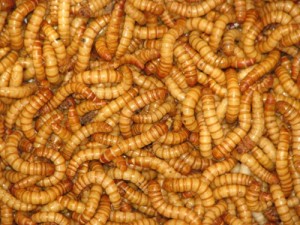Mealworms Could Replace Chicken and Beef in our Diets
Despite their deliciousness, chicken, beef and pork take a huge toll on the planet. The livestock sector uses nearly 70% of all agricultural land, and is responsible for 15% of the planet’s total greenhouse gas emissions!
Though it may make you queasy to think about today, mealworms and superworms could soon become a huge part of our diet, thanks to their high protein content and positive imprint on the environment.
In the first study of its kind, scientists at Wageningen University in the Netherlands have uncovered startling data that could lead to a dramatic shift in global tastes and cuisine.
Creepy Crawlers
With the demand for animal protein expected to rise by 70–80% through 2050, raw data shows that mealworms needs to be considered as a sustainable source of edible protein. When comparing the production of one kg of edible protein from milk, chicken, pork or beef to that of one kg from mealworms, the former resulted in higher greenhouse gas emissions and higher land occupation with approximately the same amount of energy consumption.
With global population rising at unprecedented rates and land becoming scarcer by the day, this landmark study cannot be taken lightly.
How Do They Taste?
Although mostly thought of as pet food today, mealworms are available for purchase in canned form, freeze-dried or alive and squirming. Insects are popular in many regions of the world, and mealworms are a versatile variety. Looking for a meal or a snack? Mealworms can be baked, roasted, fried, ground up, made into bread and prepared pretty much any way you can think of.
Let’s not forget that the uber-delicious delicacy Nephropidae, A.K.A. the lobster, used to be barely fit for consumption by prisoners as recently as the mid 19th century. Mealworms, which have been described a savory and tasting like unflavored popcorn, could certainly be next.
The bottom line when it comes to widespread adoption is a guise from the bare bone facts; as long as it doesn’t look like a worm and have a worm on the label, adoption shouldn’t be a huge problem.
PLOS One via Scientific American
Comments
Tags: animal greenhouse gases, best source of protein, mealworm protein, mealworm taste, mealworms, mealworms as food, superworms, Wageningen University
Trackback from your site.


Comments (1)
Lily
| #
Mmm I love eating worms.
Reply